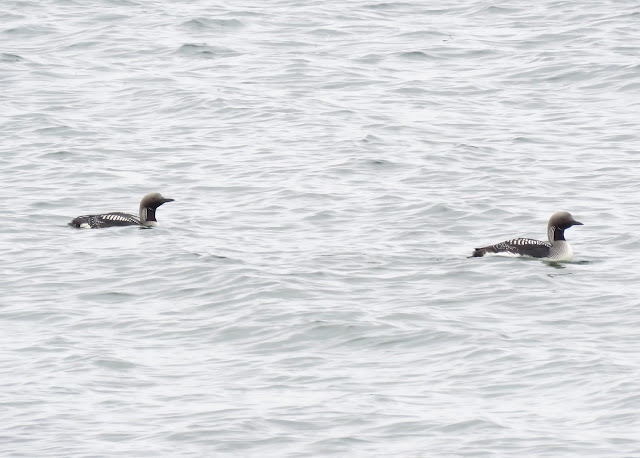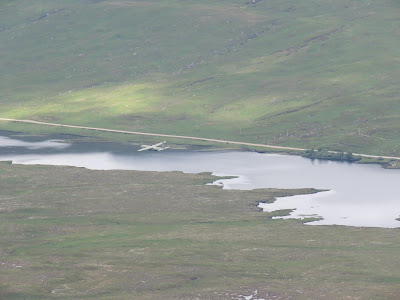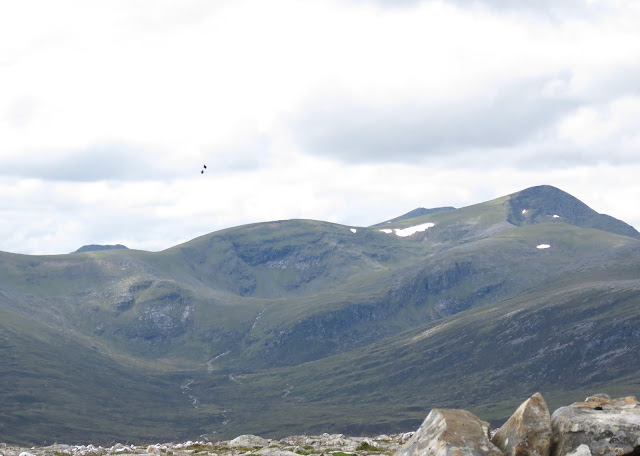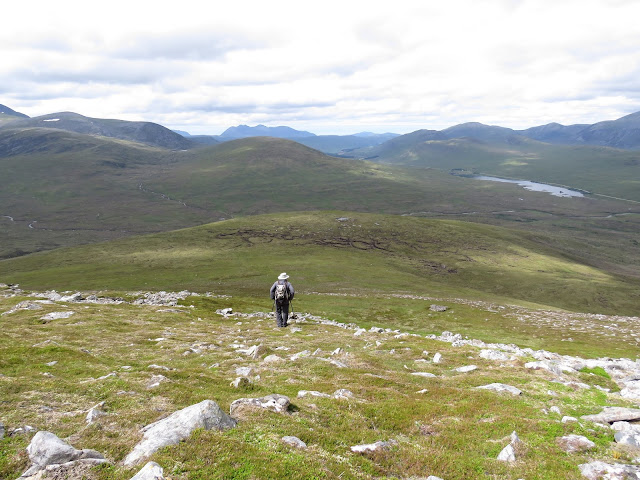Wednesday, July 29, 2020
A pair of black-throated divers lounged about just off-shore as I ate my lunch at Badentarbat.
Just beyond them was a juvenile black guillemot, while a family of Eider paddled in the shallows; and a gannet sped in and then sped out again.
Across the headland, the beach car park was pretty full but I just squeezed in. A walk around the dunes and the beach was pleasant but brought just one dunlin with three ringed plovers, a family of redpolls, and several wheatears. Three or four red-throated divers were out on the bay, and I just caught sight of a fin as either a porpoise or a dolphin broke the surface briefly - and then disappeared for good.
The explosion of tourists continues; at the car park, loads of bagged rubbish stood by the overflowing bins - which is what they ask you not to do. As most people get here by car, you would think they could easily take this rubbish away with them. I begin to despair of human beings; but at least there isn't much rubbish strewn around the place, so I s'pose we should be grateful for that. The public toilet at Badentarbat is open and has been for at least a week - so I'm not sure why they can't all be. Nicola is now urging Scots to "staycation" rather than go abroad; fine, Nicola, but in that case, get those blinking loos open - or do you expect us to cross our legs until we get home again?!
Friday, July 24, 2020
Our plan to go up Ben Wyvis came to nothing when we woke up and just didn't feel like it! We went to Rosehall again, instead - where tourism, as elsewhere, was much in evidence. Still, we managed to have a fairly quiet walk, using a grassy ride that isn't on the official trails; and this time we saw a bit more wildlife. The bee beetle landed beside us as we set off from the car park.
A pale moth fluttered past and was snapped hanging upside down; after much research on the internet I've identified it as a barred straw. (Why do insect names look wrong with a lower-case first letter, while bird names look okay?)
A juvenile stonechat was seen on high, open ground. Dropping down, we paused at the black forest junction before turning left to look along the dead-end track to the right. Several small birds were fly-catching along a fence; and then two birds scything through the air with swallows made me exclaim "Swifts!" Except that it came out as more of a shout, with an echo bouncing back seemingly from the black forest itself. These were our first swifts of the year (we'd normally have seen them by now over the river in Inverness, but my last visit there was well before lockdown); and when we walked up the track into a more open area, we could see that the small birds were a meadow pipit, a young willow warbler, a dunnock, and a family of spotted flycatchers.
On the way back to the car park we heard crossbills, and a small party of perhaps ten birds came flying over.
At the pond, a few emerald damselflies had emerged, a large bluish hawker was tirelessly active (southern hawkers were here last year), and a probable common darter landed on the wooden platform. A moth fluttering about on the pond vegetation was not, as I first thought, an injured moth in trouble, but a brown china-mark in its natural habitat whose larvae live underwater. Something else learnt today.
But the lovely flowers of ragged robin, I was sad to see, have had their day.
Tuesday, July 21, 2020
A dog walker came briefly into the field, and the godwit moved a little nearer to the sea. But it didn't fly; and when we drove away it had returned to its foraging.
The public toilets in Aultbea are still closed - so we headed back. (There are no other loos between Aultbea and Ullapool.) However, we stopped at the high viewpoint above Gruinard Bay in a bid to see black-throated divers - and soon I spotted six adults far below.
At Aultbea we'd spotted a red-throated diver, and a bit further on from Gruinard we saw two great northern divers.
Monday, July 20, 2020
It was good to visit Achnahaird again, despite a heavy shower of rain when I was in the middle of the saltmarsh. A sanderling among the ringed plovers cheered things up.
This rather drab dunlin was one of about a dozen at Badentarbat.
Also seen: two pairs of red-throated divers, about fifteen twite, a juvenile wheatear, and a solitary gannet.
Yesterday we walked sun-dappled tracks at Rosehall but saw very few birds.
At a junction of paths before the climb you pass an area of conifers, mostly spruce with some larch, that's so spookily dense and dark you can't see for more than a couple of metres in from the edge. A real black forest.
A blue-tailed damselfly was a first for me near the pond.
A nearby patch of ragged robin gave me a plant tick.
A nice name for a lovely wildflower.
Saturday, July 18, 2020
A male northern emerald dragonfly was hunting along the quarry road - this one with nice green eyes.
There was such a strong south-westerly wind blowing that I was surprised to see any dragonflies on the wing at all. A golden-ringed and a probable common hawker were the only others we managed to spot.
Monday, July 13, 2020
We paid a visit to the dam, and much to my relief the house martins (and one swallow) were flying around as usual. Looking down from the wall, we spotted a common sandpiper foraging in the moss, where snow buntings were sometimes seen back in the winter.
I wanted to see if I could catch any of the sundew plants in full flower - but, as usual, they were in bud. Looking more closely at the common hair moss with spore capsules that I snapped before, I could see now that the covers (calyptras) had the hairy appearance they're supposed to have. I'm glad I looked again, because some of the covers were splitting and some had been shed completely, revealing the angular spore capsules inside.
Also seen on our short walk: buzzard, meadow pipit, stonechat, pied wagtail, linnet, lesser redpoll, and mistle thrush.
Sunday, July 12, 2020
A willow warbler in the birch saplings on the far side of the dam betrayed its presence with a call.
Similarly, an osprey might have cruised over high above unnoticed had I not heard an unfamiliar but raptorish call (Lars Jonsson describes it as "piteous", which does the job quite well).
It was especially satisfying, in these eagleless days, to see such a wingspan crossing the empty, empty sky. But if I thought to myself "Good start!" I was in for disappointment, as this was as good as it got!
Leaving the track I negotiated rough, wet ground up to and through the deer-fence gate, only to face the next struggle over a large area of rush patches, bogs, pools, and peat hags. Several frogs were seen, and one common lizard. On the skyline of my hill, tiny figures could be seen approaching the summit from the Black Bridge approach. They kept going past the huge cairn, probably heading for Am Faochagach which is much further along the ridge.
The alarm call of a golden plover came to me faintly on the wind, but in that huge green morass I failed to spot it. I plodded upwards, swearing to myself, and after what seemed like an age, I reached the summit. The wind was now unpleasantly strong and I had to sit in the shelter of the cairn to phone Greger, letting him know I'd arrived safely. I was very tired and I decided not to go on to the second top - the wind was just too much for me, coming on top of the ankle-turning efforts to reach this point. This is the third time I've been up here; you would think I might learn.
Enjoying the fabulous view as I ate my lunch, I recalled that I was forever noting the twin-topped hill in the distance (seen here beyond Meall a' Ghrianain) either from this ridge or from Ben Wyvis, and meaning to look it up. I hadn't got round to it so far, but as I wasn't going any further today and as the birds were rubbish, I fished my map and compass out of the rucksack and took a bearing. It's Carn Chuinneag and at 838m is a Corbett, with a trig point on the right-hand summit.
After a while I had to accept that no dotterels were going to materialise, and I set off down. I lingered where the vegetation clings close to the ground, both because I love this terrain and because all too soon I would be descending into boggy hell again! As usual, I had trouble with berries. I think this is bearberry. There is an unripe berry on the right-hand side of this picture; but I wonder if it's oblate enough for bearberry.
This, I think, is Arctic bearberry.
The flank of the hill was still steep when the grass began to be tussocky and long, and any relief at reaching more level ground at the end of that was countered by the beginning of peat-hags once more. I paused to listen for the plover but could hear nothing. I scanned the sky constantly, but the wind was probably too strong by now for any sensible bird to take to the air above the hills. And as I scanned, two red grouse erupted from the ground just ahead of me and nearly gave me a heart attack. As usual, they flew low and went down some distance away - and completely out of sight.
Never mind, I'll snap this dwarf birch. I love these tiny trees. Their rounded leaves - somewhere between scalloped and serrated - look as though someone's pressed them out crisply with a pastry cutter. That's part of my boot top left, for scale.
Actually, the peat hags themselves weren't too bad - we've had a fairly dry spring; it was more the areas of sphagnum in between that caused the trouble. A large dragonfly caught my eye - but it vanished in a twinkling. Then came the three patches of rushes or reeds (I've never looked them up because I hate 'em). Judging by the fresh poo and the odd "form" of flattened stems, the dozen or so red deer I could now see on the skyline had been spending time here recently. I thought of ticks as I brushed my way through the rushes thigh-deep, but there was no way round the things - and I had at least sprayed my legs with insect repellant before putting my walking trousers on. The rushes, or sedges, or whatever, also hide trickles and pools so that you're ankle deep in muddy water before you know it.
When I reached the gate I had a long drink of water and set off on the next stage, on very uneven sloping ground with quite a few holes where they've been re-foresting, through long tangly grass and foot-catching heather. It was a relief to reach the track.
The stonechat, which was attending juveniles, was first seen on July 3rd; it has a deformed bill, which is better seen in this photo.
As I walked, I became aware of a canoe out on the water with three people in it. I don't think I've ever seen a boat of any kind on Loch Glascarnoch before. I would have thought it was a bit dangerous - after all, from the intake tower, a large pipe carries water away, under the hills and then down into Lochluichart. We always look out for the huge black pipe, at the surface in the village, coming down the slope to the power station.
Anyway, it all looked serene and safe enough, and I was nearing the end of my walk feeling fairly happy when these five charmers spoiled my day. They were taking large stones and rocks from the sloping upstream side of the dam, and throwing them down the downstream side, sometimes crashing them on the dry concrete far below, sometimes into one of the rectangular pools there.
I took a second picture after this, when they're all standing at the wall, large stones held on the parapet, and looking down. When I showed it to Greger, he agreed that they seemed to be looking either at something, or for something. And the horrible thought occurred that they were waiting for the house martins to fly out from their nests, which are under the dam wall. I hope not. Let's hope they're "just" destructive hooligans and nothing worse.
Wednesday, July 08, 2020
A dry day was promised, so we planned to try once again to get up a mountain - problem was, many a hill-walker had had the same idea! The Beinn Dearg car park was busy as we passed it, with some probably having overnighted in their cars; and the Fannichs lay-by was also full. However, we had no trouble parking on the grassy verge; and all the other walkers must have gone Munro-bagging, because we had our Corbett to ourselves.
Toiling up the wet hillside we flushed a red grouse. Further on where the rock outcropped, there was mountain everlasting growing in the moss.
In a patch of cloudberry I could find only two sepals, so we were obviously too late for the flowers.
One of two military transport planes that rumbled along Loch Droma.....
.....disappearing dramatically behind the shoulder of a hill.
After the steep, usually wet slopes (which weren't too bad, considering the recent rain), we found the peat hags also drier than we'd expected, and soon we were onto the final, thrilling stage of the walk, where the vegetation suddenly becomes shorter and crisper until it's a close fitting mat between grey and lichened rocks; and as I scanned the ground for tiny plants, Greger called out that something was moving up near the skyline.
Ptarmies! I'd hoped to see ptarmigan on our first hill-walk this year, but hadn't banked on it. So far, we'd been lucky on two visits out of three to this hill.
We were both rapidly counting - five, six....in the end Greger reckoned there were eight. I thought these were immature birds, but have since realised that they are probably adults which are moving into their grey autumn plumage.
The summit cairn was surrounded by Alpine lady's mantle.
I'd thought that the military planes were going to be the most exciting airborne thing of the walk - until we saw two red admiral butterflies sparring in flight (Sgurr Mor in the background).
The butterflies landed frequently on the summit but never for long.
Two hoverflies were also difficult to snap, this one being Sericomyia lappona; the reddish scutellum can just be seen.
This is the slightly larger Sericomyia silentis - the scutellum is blackish. This is given as an aid in separating the two species, although each one is fairly distinctive anyway.
The black spots on the rock are some kind of crustose lichen.
I wandered over the stony plateau while Greger had a second cup of coffee, and spotted some of the ptarmigan again. When they stood still it was difficult to see them; I think there are four in this pic.
We set off back down. Here, we're still on delightful walking terrain, with the peat hags visible below.
The lingering snow patches on the mountains look white until I compare them with cottongrass, which seems a pure and beautiful white especially when seen against dark moorland pools - the white of a ptarmigan's feather.
Back on the track through the plantation, willow warbler, goldcrest, wren, and a family of mistle thrushes were seen. A golden ringed dragonfly flew past and a smaller one was buzzing about; it was the right size for azure hawker but it disappeared among the pines. I paused to snap some sundew plants, which at least kept still.
What a lovely day! It was a real tonic to be up there with the rocks and the moss and the views - and most of all, the ptarmigan.
Friday, July 03, 2020
This was supposed to be a day of celebration - we could legitimately drive more than 5 miles for exercise! I didn't start it well, finding my sixth tick of the year (on my foot!) when I showered. I stayed at home yesterday, so this must have come from the garden. Note to selves - shut the garden gate at night. Of course, deer can jump over - but they might not bother if the gate is closed. Anyway, we drove up the Dirrie More and parked in the rain, our rucksacks all packed for a hill-walk. But thick cloud was down over the tops, and the rain continued....We called it off, and went for a short walk during which we flushed a male black grouse. He flew off low and unhurriedly, not going far but dropping down out of sight. Near the car park, a wheatear was spotted flying along the river - a welcome sight, as we haven't seen one since the early days of lockdown.
Our next short walk was at the dam. I think this might be a marsh fragrant-orchid, but I don't insist on it. I think I'll give up my new-found interest in orchids - too many of them are a minefield to ID, and just to make things even worse, some of them apparently hybridise.
The ditch also held the usual sundews, both common (round-leaved) and great.
These goldenish pods are, I think, spore capsules, rising on red stems from common hair moss (probably).
My thoughts went back to pre-lockdown: there were no ravens now at the nest site and the snow buntings have long departed to their breeding grounds in the uplands; but there were a few nice things to see. House martins have returned to the dam for the summer and were wheeling constantly, with one or two swallows and sand martins among them. Meadow pipits and this rather damp stonechat have clearly bred successfully.....
.....as has the common sandpiper - only the second time I've seen this species on the loch.
A bird came flying swiftly over, quite high, and was either a merganser or goosander, though I felt it had the slighter build of the former. But still no eagles. We enjoyed a bottle of Spumante when we got home, although the day hadn't quite gone the way we hoped. (The Ben Wyvis car park, to our surprise, held half a dozen cars, so some hill-walkers had been braver than us!) Looking back over my blog, I realise that in each of the previous six springs we've spent here, we'd already seen ptarmigan by now. Got some catching-up to do!














































